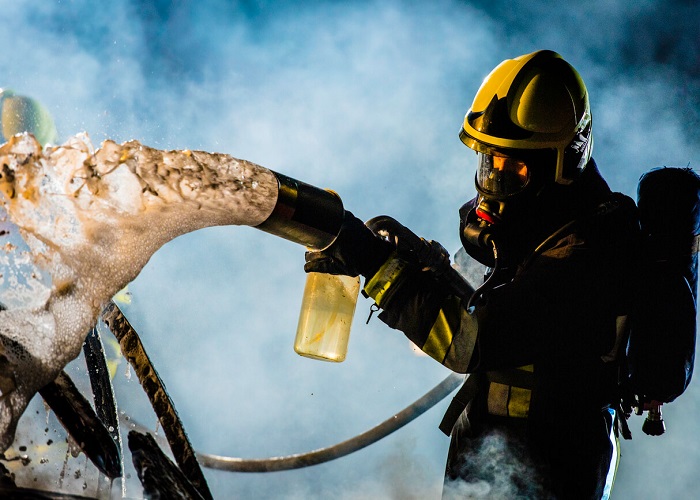Firefighters use foam to suppress it when a fire is too big for water alone to handle. Firefighters can use foam to prevent homes and other buildings from catching fire and protect people. But recently, the use of AFFF has been under scrutiny because of its negative environmental impact.
The problem with this type of foam is that it contains PFOS (perfluorooctane sulfonate). PFOS can leach into groundwater and soil and contaminate food sources like oysters, mussels, and clams. It can also directly impact firefighters, as they are constantly exposed to AFFF firefighting foams.
AFFF Composition and Concerns
AFFF is a fluorinated compound that is used to fight fires. It’s often used in military and aerospace applications, as well as firefighting foam. AFFF is made up of polyfluoroalkyl substances (PFAS), chemicals linked to cancer and other health problems.
PFAS comprises 3 – 6% by weight of the entire formulation of AFFF. Apart from PFAS, it contains nonfluorinated surfactants, various stabilizers, solubilizers, and other chemicals. PFAS are persistent and can accumulate over time. When their levels go above the safety levels, they can lead to various forms of cancer.
Due to their hazardous nature, the Environmental Protection Agency (EPA) has set limits for PFAS levels in drinking water. Any private or government body regulating drinking water supply should ensure that PFAS levels don’t rise.
Contamination Cases and Environmental Backlash
Firefighting foam manufacturers face much backlash from the public due to several contamination cases reported. According to research, PFAS in AFFF firefighting foams can leach into drinking water sources and accumulate there. When this happens, people are exposed to chemicals that are declared carcinogens.
Data shows that most Americans are already exposed to PFAS. Studies have revealed that PFAS is in the blood of 97% of Americans today. However, PFAS is not hazardous at minimal levels. That’s why not many people see any problems associated with PFAS, although they are found in 97% of US citizens.
However, AFFF firefighting foam manufacturers face backlash because cancer cases associated with AFFF use have increased. These cases are not due to environmental issues alone. Many firefighters who use AFFF foam daily have been diagnosed with various cancers. Hence, victims, their friends, and their families are filing lawsuits against these manufacturers.
Legal Landscape: AFFF Lawsuits
As a result of the growing concern surrounding AFFF foam, the number of lawsuits has been steadily increasing over the past decade. The number of firefighting foam lawsuit cases has grown so much that they are now consolidated into multidistrict litigation (MDL).
According to TorHoerman Law, around 6,000 cases have been consolidated into MDL. It also states that the water contamination settlements are nearing $10.3 billion globally. This settlement amount is for municipalities that have filed lawsuits against manufacturers for water contamination.
When it comes to firefighters and individuals who have filed lawsuits, the settlement amount is not decided yet. The AFFF lawsuit settlement amounts can range from $40,000 to $300,000 and even more. The amount you receive will depend on several factors. For instance, the severity of the health concern, how long you have been exposed to PFAS, medical expenses, etc., will all influence the settlement amounts.
Health Concerns Related to AFFF Exposure
AFFF is a complex mixture of chemicals, and the health effects of AFFF are not well understood. Many types of foam products vary by manufacturer, formulation, intended use, and application method.
The general public’s exposure to AFFF has increased significantly since its introduction in the 1970s due to its widespread use in fighting fires. AFFF has widespread applications that involve Class B fires. Apart from the military, the primary use sectors are municipal fire departments, petroleum refineries, and aviation. Each Nimitz Class aircraft carrier in the US military carries approximately 20,000 gallons of AFFF concentrate.
As the use of AFFF is increasing, many health concerns associated with it are coming out. Here are some health concerns related to AFFF exposure, particularly PFAS exposure:
- Potential carcinogenic effects: Some studies have suggested a possible link between exposure to certain PFAS and an increased risk of cancer, particularly kidney and testicular cancer. However, more research is needed to establish a definitive connection.
- Liver and thyroid issues: There is evidence that exposure to certain PFAS may be associated with liver damage and changes in thyroid hormone levels. This can affect thyroid function and lead to more complex health issues.
- Developmental and reproductive effects: Animal studies have shown that exposure to PFAS may adversely affect fetal development and reproductive organs. Human studies are ongoing to understand the potential risks to human reproduction and development.
- Immune system effects: Some studies have suggested that exposure to PFAS may impact the immune system, potentially reducing the effectiveness of the immune response.
Regulatory Responses and Industry Changes
As people started realizing the harmful effects of AFFF, the federal government made many regulatory changes. For instance, AFFF manufacturers have been forced to change their production processes. They can no longer make large quantities of AFFF foam using PFOS-containing surfactants.
Many firefighting companies have switched to using water-based foams instead of AFFF foams because they feel safer for the environment and humans. However, some argue that these new types of foam may not be as effective in fighting fires or preventing oil spills.
The U.S. Environmental Protection Agency (EPA) has been working to address PFAS contamination and has taken steps to regulate and manage PFAS substances. Some states have also implemented or proposed regulations regarding the use and disposal of AFFF-containing PFAS.
Future Outlook
The future of AFFF is uncertain, but there are some things that are clear. First, AFFF manufacturers face a lot of backlash because of the environmental issues associated with the product. Second, many legal challenges have been brought against them and government agencies that approve their use.
More than 6,400 PFAS-related lawsuits have been filed in federal courts between July 2005 and March 2022. Any company using PFAS in its finished products can face lawsuits. 3M was named in an average of more than three PFAS-related lawsuits per day last year. This means that manufacturers might likely stop using PFAS-based AFFF firefighting foam.
But while the outlook may seem grim, there’s hope! Manufacturers are taking several actions to mitigate environmental damage and ensure their products remain safe for firefighters and civilians. If the research pays off, new solutions that are as effective in firefighting but less hazardous than PFAS-based AFFF will be found.
Conclusion
AFFF is a controversial chemical that has faced much backlash from the public. This is especially true in areas where AFFF firefighting foam has been used for decades. Many unanswered questions exist about its effects on human health and the environment. However, we know enough now that this product needs to be regulated more strictly than before.
The good news is that companies are making their products safer. However, until these innovations become widespread across industries worldwide, you may still be exposed to harmful chemicals while performing everyday tasks.




